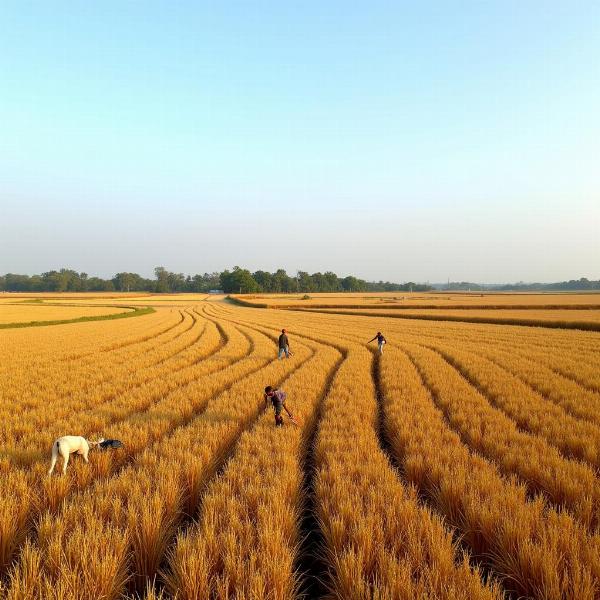Jute ka hindi meaning? Simply put, it’s पटसन (patson). But understanding the true meaning of jute goes beyond just a simple translation. It delves into the rich cultural, economic, and historical significance this golden fiber holds, especially within India. This article explores the various aspects of jute, from its linguistic roots to its versatile applications, shedding light on why knowing its Hindi meaning is just the beginning of a fascinating journey.
Exploring the Linguistic Roots of “Jute”
The word “jute” itself has an interesting etymology, originating from the Oriya word “jhuta” or the Bengali word “jhōṭā,” ultimately deriving from the Sanskrit word “juta,” referring to braided hair. This connection highlights the fiber’s inherent nature – strong, pliable, and woven into the fabric of various cultures. Knowing its Hindi counterpart, पटसन (patson), connects us to the heart of its usage in India, where it’s not just a material but a part of daily life and traditions.
Jute: A Versatile Fiber with Diverse Applications
Beyond its linguistic roots, jute’s importance lies in its versatility. From ropes and sacks to carpets and handicrafts, jute’s uses are incredibly diverse. In India, where it’s a major crop, its significance is amplified. Understanding “jute ka hindi meaning” as पटसन (patson) opens up a world of understanding about its applications within Indian contexts, from agricultural practices to household items.
Traditional Uses of Jute in India
Traditionally, jute has been integral to Indian agriculture, used for making ropes, sacks for storing grains, and packaging materials. This continues to be a significant application, reinforcing the importance of knowing “jute ka hindi meaning” – पटसन (patson) – for anyone involved in the agricultural sector. Moreover, jute’s role extends to traditional crafts, where it’s woven into beautiful bags, mats, and decorative items, showcasing the artistic heritage associated with the fiber.
Modern Applications of Jute
Jute’s usage has also evolved with time. Today, it’s increasingly recognized for its eco-friendly nature, making it a popular choice for sustainable packaging, carpet meaning in hindi and fashionable accessories. From high-end fashion items to home decor, jute’s versatility is constantly being explored. This wider acceptance and global demand further highlight the value of understanding “jute ka hindi meaning.”
The Economic Significance of Jute in India
India is one of the largest producers of jute in the world. The industry provides livelihoods for millions, particularly in West Bengal and surrounding regions. Knowing “jute ka hindi meaning” as पटसन (patson) allows for a deeper understanding of its economic impact, connecting the fiber to the people whose lives are intertwined with its cultivation and processing. The economic relevance of jute also extends to international trade, where India plays a crucial role in exporting this valuable commodity.
 Jute farming in India
Jute farming in India
Why Knowing “Jute Ka Hindi Meaning” Matters
Understanding “jute ka hindi meaning” as पटसन (patson) is not just about vocabulary. It’s about connecting with the rich tapestry of Indian culture, economy, and history interwoven with this golden fiber. burlap meaning in hindi It’s about appreciating the journey from the farm to the finished product, recognizing the livelihoods it supports and the traditions it upholds. soled meaning in hindi
Conclusion
From its humble beginnings as braided hair to its modern applications in sustainable living, jute’s journey is fascinating. Knowing “jute ka hindi meaning” as पटसन (patson) is the key to unlocking a deeper understanding of this versatile fiber’s significance, particularly within the Indian context. match ka hindi meaning It connects us to the people, the processes, and the rich cultural heritage associated with this golden fiber. hindi meaning of heels
FAQ
- What is the exact Hindi meaning of jute? पटसन (patson)
- What are the primary uses of jute in India? Jute is primarily used in India for making sacks, ropes, and packaging materials, as well as in traditional crafts.
- Why is jute considered eco-friendly? Jute is biodegradable and renewable, making it a sustainable alternative to synthetic materials.
- Where is jute mainly cultivated in India? West Bengal is the largest jute producing state in India.
- What is the economic significance of jute in India? The jute industry provides employment to millions of people in India and contributes significantly to the country’s exports.
- Is jute used in fashion and home decor? Yes, jute is increasingly used in fashion accessories, home decor items, and furniture due to its natural and eco-friendly qualities.
- What are some traditional Indian crafts made from jute? Bags, mats, wall hangings, and decorative items are some traditional Indian crafts made from jute.
Meaning-Hindi.in offers professional translation services specializing in various fields, including business, legal, technical, website localization, educational, and specialized content. We provide accurate and culturally sensitive translations, ensuring your message resonates effectively with your target audience. Whether you need business documents translated or require specialized technical translation, our expert team delivers high-quality results. Contact us at [email protected] or call us at +91 11-4502-7584. Meaning-Hindi.in is your trusted partner for all your Hindi translation needs.